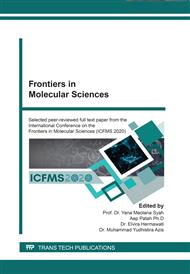[1]
N.V. Plechkova, K.R. Seddon, Applications of ionic liquids in the chemical industry, Chem. Soc. Rev. 37 (2008) 123-150.
DOI: 10.1039/b006677j
Google Scholar
[2]
S. Kadotani, T. Nokami, T. Itoh, Enhanched activity and modified substrate-favoritism of Burkholderia cepacia lipase by the treatment with a pyridinium alkyl-PEG sulfate ionic liquid, Tetrahedron 75 (2019) 441-447.
DOI: 10.1016/j.tet.2018.12.028
Google Scholar
[3]
M.d. Nascimento, J.M.R. da Silva, J.C. da Silva, M.M. Alves, The use of organic solvents/ionic liquids mixtures in reactions catalyzed by lipase from Burkholderia cepacia immobilized in different supports, J. Mol. Catal. B Enzym. 112 (2015) 1-8.
DOI: 10.1016/j.molcatb.2014.11.013
Google Scholar
[4]
F. Su, C. Peng, G. Li, L. Xu, Y. Yan, Biodiesel production from woody oil catalyzed by Candida rugosa lipase in ionic liquid, Renew. Energy 90 (2016) 329-335.
DOI: 10.1016/j.renene.2016.01.029
Google Scholar
[5]
L. Na, D. Weiyan, H. Zhuonan, Z. Wei, W. Shoujiang, Effect of imidazolium ionic liquids on the hydrolytic activity of lipase, Chinese J. Catal. 34 (2013) 769-780.
Google Scholar
[6]
F. J. Contesini, P.d. Carvalho, Esterification of (RS)-Ibuprofen by native and commercial lipases in a two-phase system containing ionic liquids, Tetrahedron: Asymmetry 17 (2006) 2069-2073.
DOI: 10.1016/j.tetasy.2006.07.020
Google Scholar
[7]
M.A.M. Latif, N.M. Micaelo, M.B.A. Rahman, Influence of anion-water interactions on the behavior of lipases in room temperature ionic liquids, RSC Adv. 4 (2014) 48202-48211.
DOI: 10.1039/c4ra07460b
Google Scholar
[8]
P.R. Burney, J. Pfaendtner, Structural and dynamic features of Candida rugosa lipase 1 in water, octane, toluene, and ionic liquids BMIM-PF6 and BMIM-NO3, J. Phys. Chem. B 117 (2013) 2662-2670.
DOI: 10.1021/jp312299d
Google Scholar
[9]
M. Potangale, A. Das, S. Kapoor, S. Tiwari, Effect of anion and alkyl chain length on the structure and interactions of N-alkyl pyridinium ionic liquids, J. Mol. Liq. 240 (2017) 694-707.
DOI: 10.1016/j.molliq.2017.05.036
Google Scholar
[10]
P. Grochulski, Y. Li, J.D. Schrag, M. Cygler, Two conformational states of Candida rugosa lipase, Protein Sci. 3 (1994) 82-91.
DOI: 10.1002/pro.5560030111
Google Scholar
[11]
H.J.C. Berendsen, D. van der Spoel, R. van Drunen, GROMACS: A message-passing parallel molecular dynamics implementation, Comput. Phys. Commun. 91 (1995) 43-56.
DOI: 10.1016/0010-4655(95)00042-e
Google Scholar
[12]
W.R.P. Scott, P.H. Hunenberger, I.G. Tironi, A.E. Mark, S.R. Billeter, J. Fennen, A.E. Torda, T. Huber, P. Kruger, W.F. van Gunsteren, The GROMOS biomolecular simulation program package, J. Phys. Chem. A 103 (1999) 3596-3607.
DOI: 10.1021/jp984217f
Google Scholar
[13]
J. Hermans, H.J.C. Berendsen, W.F. van Gunsteren, J.P.M. Postma, A consistent empirical potential for water-protein interactions, Biopolymers 23 (1984) 1513-1518.
DOI: 10.1002/bip.360230807
Google Scholar
[14]
A.K. Malde, L. Zuo, M. Breeze, M. Stroet, D. Poger, P.C. Nair, C. Oostenbrink, A.E. Mark, An automated force field topology builder (ATB) and repository: version 1.0, J. Chem. Theory Comput. 7 (2011) 4026-4037.
DOI: 10.1021/ct200196m
Google Scholar
[15]
L. Martinez, R. Andrade, E.G. Birgin, J.M. Martinez, Packmol: a package for building initial configurations for molecular dynamics simulations, J. Comput. Chem. 30 (2009) 2157-2164.
DOI: 10.1002/jcc.21224
Google Scholar
[16]
H.J.C. Berendsen, J.P.M. Postma, W.F. van Gunsteren, A. Dinola, J.R. Haak, Molecular dynamics with coupling to an external bath, J. Chem. Phys. 81 (1984) 3684-3690.
DOI: 10.1063/1.448118
Google Scholar
[17]
T. Darden, D. York, L. Pedersen, Particle mesh Ewald: an N-log(N) method for Ewald sums in large systems, J. Chem. Phys. 98 (1993) 10089.
DOI: 10.1063/1.464397
Google Scholar
[18]
B. Hess, H. Bekker, H.J.C. Berendsen, J.G.E.M. Faraaije, LINCS: A linear constraint solver for molecular simulations, J. Comput. Chem. 18 (1997) 1463-1472.
DOI: 10.1002/(sici)1096-987x(199709)18:12<1463::aid-jcc4>3.0.co;2-h
Google Scholar
[19]
W. Humphrey, A. Dalke, K. Schulten, VMD: Visual molecular dynamics, J. Mol. Graphics 14 (1996) 33-38.
DOI: 10.1016/0263-7855(96)00018-5
Google Scholar
[20]
T.T. Herskovits, B. Gadegbeku, H. Jaillet, On the structural stability and solvent denaturation of proteins, J. Biol. Chem. 245 (1970) 2588-2598.
DOI: 10.1016/s0021-9258(18)63111-4
Google Scholar


